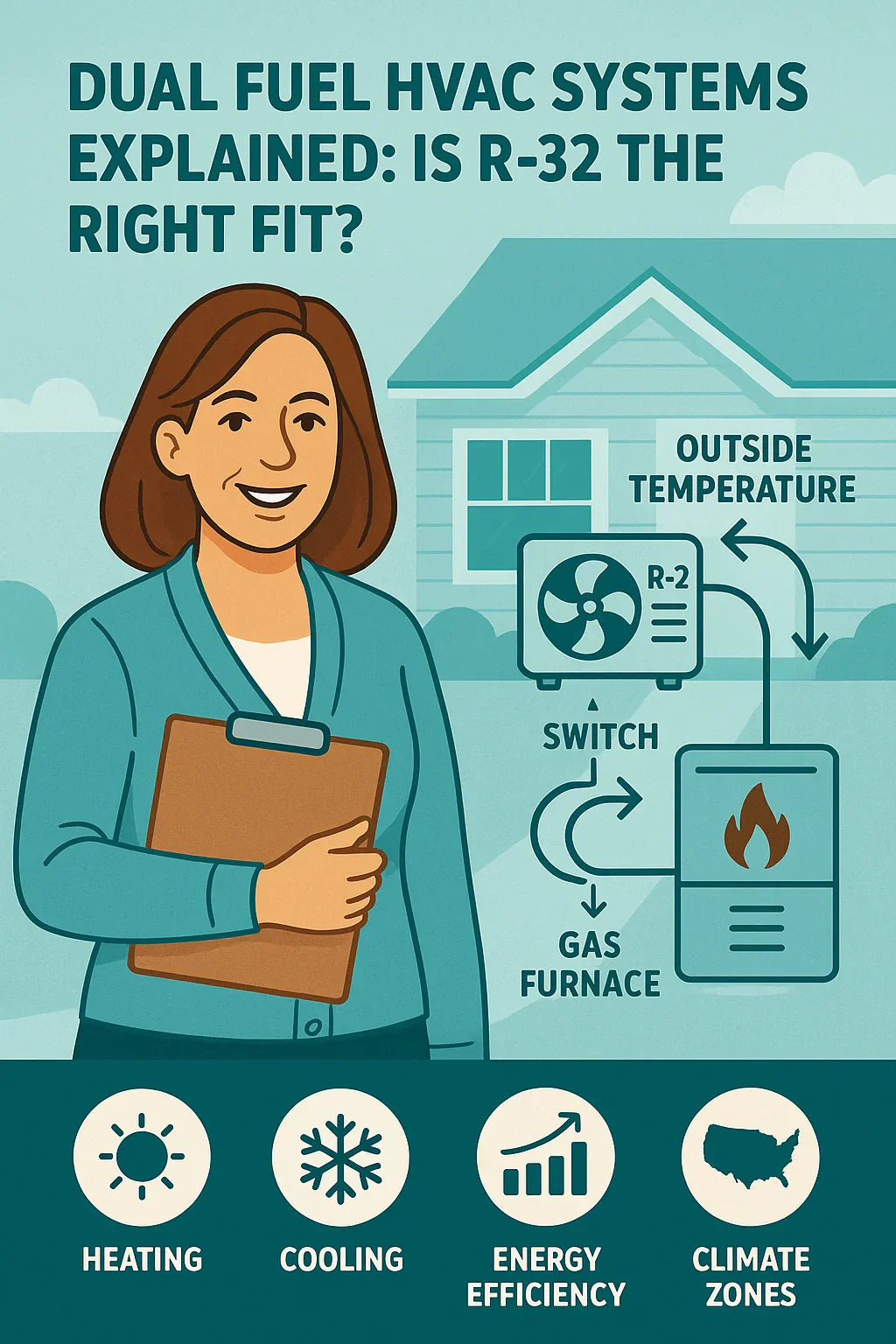For homeowners looking to balance year-round comfort with energy efficiency and cost savings, dual fuel HVAC systems are becoming an increasingly popular option. These systems combine the electric efficiency of a heat pump with the raw heating power of a gas furnace—giving you the best of both worlds.
But with the shift to newer refrigerants like R-32, many are wondering: Does R-32 work with dual fuel systems? And is it the right choice for your home climate and utility setup?
This guide will help you explore how dual fuel systems operate, the benefits of pairing one with an R-32-based heat pump, and how to decide whether this hybrid approach is right for your household.
⚙️ What Is a Dual Fuel HVAC System?
A dual fuel HVAC system consists of:
-
An electric heat pump (for cooling and light heating)
-
A gas furnace (for backup or supplemental heating)
-
A smart thermostat or control board that switches between the two based on outdoor temperature or efficiency
In warmer temperatures, the heat pump does most of the work. When temperatures drop below a certain threshold (usually 35–40°F), the gas furnace kicks in for faster, more powerful heating.
👉 ENERGY STAR Dual Fuel Overview
🌡️ Why Use Dual Fuel in the First Place?
-
Energy savings: Electric heat pumps are cheaper to run than gas furnaces in mild weather
-
Improved performance: Gas heat handles extreme cold better
-
Lower emissions: You burn less fossil fuel throughout the year
-
Comfort control: Seamless switching prevents performance dips
❄️ Where Dual Fuel Systems Make the Most Sense
Dual fuel is ideal for mixed-climate zones where winters are cold but not extreme. Think:
-
Mid-Atlantic
-
Midwest
-
Upper South
-
Pacific Northwest
In these areas, you get efficient cooling in summer and moderate heating in spring/fall via the heat pump. Then, on freezing days, the furnace takes over.
👉 Use this U.S. climate map from Building America
♻️ Why Pair R-32 with a Dual Fuel System?
R-32 refrigerant has a 67% lower Global Warming Potential (GWP) than R-410A and delivers better energy efficiency. Here’s why it works well in a dual fuel setup:
-
Less energy to cool in summer
-
Better heat transfer performance for mild heating days
-
Lower carbon footprint across both modes
-
More compact equipment design
With R-32, your electric side is more efficient AND more eco-friendly.
👉 Benefits of Low-GWP Refrigerants
🔧 Can My Installer Set Up R-32 in a Dual Fuel Configuration?
Yes, but it requires:
-
R-32-compatible heat pump equipment
-
Matched air handler or coil unit
-
Compatible gas furnace
-
Smart thermostat with dual fuel capability (e.g., Ecobee, Honeywell T10)
-
Proper refrigerant line sizing and charge management
Always hire a licensed HVAC contractor certified in A2L (mildly flammable) refrigerants like R-32.
👉 AHRI Directory: Find Certified Equipment
🧾 Are There Rebates or Incentives for Dual Fuel R-32 Systems?
Absolutely. These systems may qualify for:
-
Federal 25C tax credits up to $2,000
-
ENERGY STAR rebates
-
State and local utility incentives for heat pumps and high-efficiency furnaces
R-32 helps your SEER2 and HSPF2 ratings meet rebate thresholds.
👉 DSIRE: Full Database of Energy Incentives
⚠️ Important Limitations and Considerations
-
R-32 is not compatible with older R-410A equipment
-
Retrofits are not recommended — buy purpose-built units
-
Mild flammability classification (A2L) means special handling is needed
-
Not ideal for very cold climates that rely 100% on gas heat
If your area routinely drops below 10°F, consider a gas-only or cold-climate heat pump system instead.
✅ Is a Dual Fuel R-32 System Right for You?
Yes, if you:
-
Live in a mixed climate
-
Want to reduce your gas usage
-
Plan to upgrade both your AC and furnace at the same time
-
Want to future-proof against refrigerant phaseouts
No, if you:
-
Have a fully functioning system and want to retrofit
-
Live in extreme cold and need full gas backup
-
Don’t have a contractor familiar with R-32
🏠 Final Thoughts: A Balanced, Smarter HVAC Setup
A dual fuel HVAC system using R-32 refrigerant combines modern efficiency with practical heating power. It’s perfect for homeowners who want to cut costs in the shoulder seasons, reduce emissions, and future-proof their investment.
If you're replacing your HVAC system in 2025, ask about dual fuel compatibility and R-32 refrigerant options. Many 2.5-ton systems available at The Furnace Outlet offer exactly this hybrid comfort solution.
In the next topic we will kow more about: SEER2 Ratings and R-32: A Match Made for Lower Bills?







